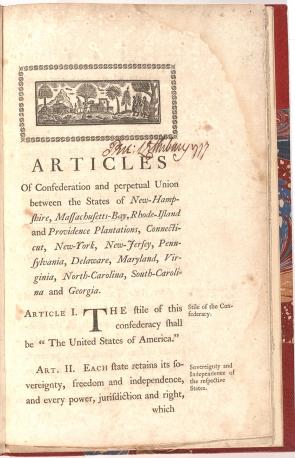what is the procedure by which congress was to raise funds?
 A solar day after appointing a committee to write the Declaration of Independence, the Second Continental Congress named another committee to write the Articles of Confederation. The members worked from June 1776 until November 1777, when they sent a draft to us for ratification. On December 16, 1777, Virginia became the first country to ratify the Articles of Confederation. Maryland was the last, belongings out until March 1, 1781.
A solar day after appointing a committee to write the Declaration of Independence, the Second Continental Congress named another committee to write the Articles of Confederation. The members worked from June 1776 until November 1777, when they sent a draft to us for ratification. On December 16, 1777, Virginia became the first country to ratify the Articles of Confederation. Maryland was the last, belongings out until March 1, 1781.
More of a treaty—or a "firm league of friendship"—than a constitution, the Manufactures of Confederation in no way infringed upon the sovereignty of the original thirteen states. Each land held "its sovereignty, freedom, and independence, and every power, jurisdiction, and right, which is not by this confederation expressly delegated to the Us, in Congress assembled." The Congress, the primary organ of the new national government, but had the power to declare war, appoint military machine officers, sign treaties, make alliances, appoint strange ambassadors, and manage relations with the American Indians. All states were represented every bit in Congress, and 9 of the thirteen states had to corroborate a bill earlier it became police. Amendments required the approval of all united states of america.
The Articles of Confederation represented an attempt to balance the sovereignty of united states of america with an constructive national government. Under the Manufactures, the states, not Congress, had the power to tax. Congress could heighten money just by request the states for funds, borrowing from strange governments, and selling western lands. In addition, Congress could non typhoon soldiers or regulate trade. There was no provision for national courts or a chief executive.
Importantly, the Manufactures did not establish a genuinely republican government. Ability was full-bodied in a unmarried assembly, rather than being divided, as in the country governments, into separate houses and branches. Further, members of the Confederation Congress were selected past land governments, non past the people.
The Articles served as the nation'due south plan of government until the US Constitution was ratified in 1788.
A full transcript is available.
Excerpts
ARTICLES
Of Confederation and perpetual Union between the States of New-Hampshire, Massachusetts-Bay, Rhode Island and Providence Plantations, Connecticut, New-York, New-Jersey, Pennsylvania, Delaware, Maryland, Virginia, North-Carolina, South-Carolina and Georgia.
Article 1.
The Stile of this confederacy shall exist "The United states of America".
Fine art. II.
Each land retains its sovereignty, freedom, and independence, and every power, jurisdiction, and right, which is not by this confederation expressly delegated to the United states of america, in Congress assembled.
ART. 3.
The said states hereby severally enter into a firm league of friendship with each other, for their common defence force, the security of their liberties, and their common and general welfare, binding themselves to assist each other, against all force offered to, or attacks made upon them, or any of them, on account of religion, sovereignty, trade, or any other pretense any.
ART. IV.
The improve to secure and perpetuate mutual friendship and intercourse among the people of the different states in this union, the free inhabitants of each of these states, paupers, vagabonds, and fugitives from justice excepted, shall be entitled to all privileges and immunities of free citizens in the several states; and the people of each state shall have free ingress and regress to and from whatsoever other country, and shall relish therein all the privileges of trade and commerce, subject to the same duties, impositions, and restrictions every bit the inhabitants thereof respectively, provided that such restrictions shall not extend and so far as to preclude the removal of property imported into any state, to any other country, of which the owner is an inhabitant; provided also that no imposition, duties or restriction shall be laid by any country, on the property of the united states, or either of them.
If any person guilty of, or charged with, treason, felony, or other loftier misdemeanor in any state, shall flee from justice, and be establish in whatever of the united states, he shall, upon demand of the Governor or executive power of the land from which he fled, be delivered upwardly and removed to the state having jurisdiction of his law-breaking.
Full faith and credit shall be given in each of these states to the records, acts, and judicial proceedings of the courts and magistrates of every other state.
Art. V.
For the more than convenient management of the general interests of the united states, delegates shall be annually appointed in such style as the legislature of each country shall directly, to see in congress on the first Monday in November, in every yr, with a power reserved to each land to recall its delegates, or whatever of them, at any time within the year, and to transport others in their stead, for the residual of the year. . . .
In determining questions in the the states in congress assembled, each state shall take i vote.
Freedom of spoken language and argue in congress shall non be impeached or questioned in whatsoever court or place out of congress, and the members of congress shall be protected in their persons from arrests or imprisonments, during the time of their going to and from, and attendence on congress, except for treason, felony, or breach of the peace. . . .
Source: https://www.gilderlehrman.org/history-resources/spotlight-primary-source/articles-confederation-1777
Post a Comment for "what is the procedure by which congress was to raise funds?"